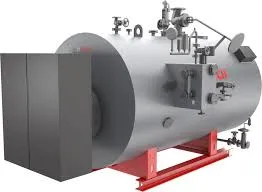
Nov . 11, 2024 06:26 Back to list
boiler steam boiler
Understanding Steam Boilers A Comprehensive Overview
Steam boilers play a crucial role in various industrial processes, power generation, and even residential heating. They are devices designed to convert water into steam through the application of heat. This steam, in turn, is employed for a myriad of applications, including heating systems, electricity production, and providing mechanical power. In this article, we will delve into the fundamentals of steam boilers, their types, components, and their significance across different sectors.
The Fundamentals of Steam Boilers
At its core, a steam boiler operates on the principle of thermodynamics, specifically the conversion of thermal energy into mechanical energy. When heat is applied to water, it transitions into steam, which occupies a greater volume than its liquid form. This property allows steam to be harnessed for work, making it an efficient medium for energy transmission.
Steam boilers primarily consist of a pressure vessel where the water is heated, along with various components that facilitate heat transfer and steam production. The design and operation of these boilers can vary widely depending on the intended application and the fuel source used.
Types of Steam Boilers
There are mainly two categories of steam boilers fire-tube and water-tube boilers.
1. Fire-tube Boilers In fire-tube boilers, hot gases produced by the burning fuel pass through tubes that are submerged in water. The heat from the gases transfers to the water, converting it into steam. Fire-tube boilers are known for their simplicity and ease of operation, making them popular in smaller applications where demand for steam is moderate.
2. Water-tube Boilers In contrast, water-tube boilers feature water-filled tubes that are surrounded by hot combustion gases. This design allows for higher steam production rates and is more suitable for large-scale operations, such as power plants and industrial facilities. Water-tube boilers are notable for their efficiency and ability to handle high-pressure operations.
Key Components of a Steam Boiler
Understanding the parts that compose a steam boiler is essential for appreciating its operation. Here are some critical components
- Burner The burner is responsible for fueling the combustion process. It mixes fuel with air and ignites it to produce heat.
boiler steam boiler

- Heat Exchanger This component allows for maximum heat transfer from the combustion gases to the water. In many systems, this is integrated within the boiler design.
- Pressure Vessel The pressure vessel is where water is heated and steam is generated. It is built to withstand high pressure and temperature.
- Safety Valves Safety valves are critical for preventing an explosion due to excessive pressure build-up. They automatically release steam when the pressure exceeds the limit.
- Control Systems Modern boilers are equipped with sophisticated control systems to monitor and regulate temperature, pressure, and overall performance for safety and efficiency.
Importance of Steam Boilers in Various Sectors
Steam boilers serve crucial functions across different industries
- Power Generation In thermal power plants, steam boilers convert water into steam, which drives turbines to generate electricity. This process is fundamental to the global energy supply.
- Manufacturing Many manufacturing processes require steam for heating and processing materials. From food production to chemical manufacturing, steam boilers ensure that operations run smoothly and efficiently.
- Heating Systems In residential and commercial buildings, steam boilers are used for space heating and hot water supply. They offer efficient heating solutions that can be scaled for different sizes of buildings.
- Healthcare In healthcare facilities, steam is essential for sterilization processes and maintaining hygiene standards. Steam boilers provide the necessary heat for autoclaves and other sterilization equipment.
Conclusion
Steam boilers are undeniably vital components of our industrial landscape and everyday life. Their ability to convert water into steam for diverse applications significantly impacts power production, manufacturing, and heating. As technology advances, the efficiency and safety of steam boilers continue to improve, paving the way for sustainable practices in energy and industrial processes. Understanding their operation, types, and components allows us to appreciate their role in various sectors and their contribution to modern society. Whether in an industrial plant or a residential heating system, steam boilers remain a pivotal technology in our quest for energy solutions and operational efficiency.
-
High-Efficiency Commercial Oil Fired Steam Boiler for Industry
NewsJul.30,2025
-
High-Efficiency Biomass Fired Thermal Oil Boiler Solutions
NewsJul.30,2025
-
High Efficiency Gas Fired Thermal Oil Boiler for Industrial Heating
NewsJul.29,2025
-
High-Efficiency Gas Fired Hot Water Boiler for Sale – Reliable & Affordable
NewsJul.29,2025
-
High Efficiency Biomass Fired Hot Water Boiler for Industrial and Commercial Use
NewsJul.29,2025
-
High-Efficiency Biomass Fired Hot Water Boiler for Industrial Use
NewsJul.28,2025
Related PRODUCTS






















